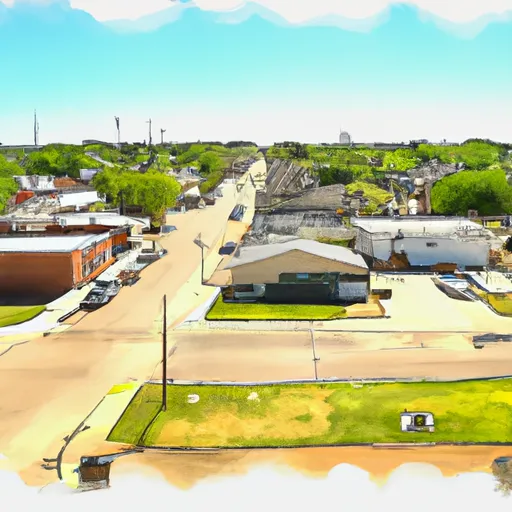-
 Snoflo Premium
Snoflo Premium
Get unlimited access to all our content
With no Ad interruptions! - Start Your Free Trial Login with existing account
Mulhall
Eden Index
Climate
8.3
•
Recreation
1.4
•
Community
0.8
•
Safeguard
4.0/10

Mulhall, Oklahoma is a small town located in Logan County, in the central part of the state. The climate in Mulhall is classified as humid subtropical, with hot summers and mild winters. Summers are generally hot and humid, with temperatures often reaching the mid-90s°F (mid-30s°C), while winters are relatively mild, with average temperatures ranging from the mid-30s°F (around 0°C) to the low 50s°F (around 10°C).
The hydrology constituents in Mulhall are primarily influenced by the Cimarron River, which runs through the western part of the town. This river provides a valuable water source for the local agriculture and supports diverse wildlife in the area.
Mulhall offers several outdoor recreation opportunities. The town is surrounded by beautiful natural landscapes, including rolling hills, forests, and open prairies. These landscapes make Mulhall an ideal destination for activities such as hiking, camping, and wildlife observation. Additionally, the Cimarron River provides opportunities for fishing and boating, allowing visitors to enjoy water-based activities. With its pleasant climate and diverse outdoor recreational opportunities, Mulhall is a charming destination for nature lovers and those seeking a peaceful retreat in the heart of Oklahoma.
What is the Eden Index?
The Snoflo Eden Index serves as a comprehensive rating system for regions, evaluating their desirability through a holistic assessment of climate health, outdoor recreation opportunities, and natural disaster risk, acknowledging the profound impact of these factors on livability and well-being.
Climate Health Indicator (CHI): 8.3
Mulhall receives approximately
880mm of rain per year,
with humidity levels near 81%
and air temperatures averaging around
16°C.
Mulhall has a plant hardyness factor of
7, meaning
plants and agriculture in this region tend to thrive during the non-winter months.
By considering the ideal temperature range, reliable water supplies, clean air, and stable seasonal rain or snowpacks, the Climate Health Indicator (CHI) underscores the significance of a healthy climate as the foundation for quality living.
A healthy climate is paramount for ensuring a high quality of life and livability in a region, fostering both physical well-being and environmental harmony. This can be characterized by ideal temperatures, reliable access to water supplies, clean air, and consistent seasonal rain or snowpacks.
Weather Forecast
Streamflow Conditions
Lower Cimarron
Area Rivers
Lower Cimarron
Snowpack Depths
Lower Cimarron
Reservoir Storage Capacity
Lower Cimarron
Groundwater Levels
Recreational Opportunity Index (ROI): 1.4
The Recreational Opportunity Index (ROI) recognizes the value of outdoor recreational options, such as parks, hiking trails, camping sites, and fishing spots, while acknowledging that climate plays a pivotal role in ensuring the comfort and consistency of these experiences.
Access to outdoor recreational opportunities, encompassing activities such as parks, hiking, camping, and fishing, is crucial for overall well-being, and the climate plays a pivotal role in enabling and enhancing these experiences, ensuring that individuals can engage in nature-based activities comfortably and consistently.
Camping Areas
| Campground | Campsites | Reservations | Toilets | Showers | Elevation |
|---|---|---|---|---|---|
| Liberty Lake | None | 1,025 ft | |||
| Guthrie Lake | None | 993 ft | |||
| Lake Thunderbird State Park - North | None | 1,081 ft | |||
| Wellington Lake East Rec Area | None | 1,225 ft | |||
| Wellington Lake West Rec Area | None | 1,216 ft | |||
| Chandler City Park - Purcell | 25 | 1,091 ft | |||
| Lake Thunderbird State Park - South | None | 1,146 ft | |||
| Tinker AFB Military | None | 1,253 ft | |||
| Perry Lake | 10 | 1,105 ft | |||
| Arcadia Lake | 140 | 1,062 ft |
Catastrophe Safeguard Index (CSI):
The Catastrophe Safeguard Index (CSI) recognizes that natural disaster risk, encompassing floods, fires, hurricanes, and tornadoes, can drastically affect safety and the overall appeal of an area.
The level of natural disaster risk in a region significantly affects safety and the overall livability, with climate change amplifying these risks by potentially increasing the frequency and intensity of events like floods, fires, hurricanes, and tornadoes, thereby posing substantial challenges to community resilience and well-being.
Community Resilience Indicator (CRI): 0.8
The Community Resilience Indicator (CRI) recognizes that education, healthcare, and socioeconomics are crucial to the well-being of a region. The CRI acknowledges the profound impact of these elements on residents' overall quality of life. By evaluating educational resources, healthcare accessibility, and economic inclusivity, the index captures the essential aspects that contribute to a thriving community, fostering resident satisfaction, equity, and social cohesion.

